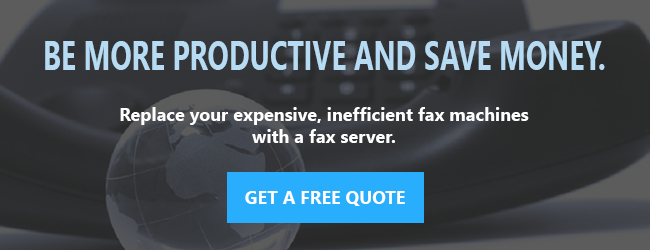What is a fax server?

A fax server is a physical or virtual server connected to a local area network (LAN) that allows computer users to send and receive fax messages from any computer that’s connected to the LAN.
Alternatively, the term “fax server” can be used to describe a software program that enables fax messages to be sent or received from a computer. The fax software running on a server works in tandem with one or more dedicated fax boards connected to telephone lines. More recently, virtual fax board software (emulators) that use T.38 (“Fax over IP”) technology to transmit the fax audio signal over an IP network are used in place of physical fax board hardware or fax modem boards.
What Does a Fax Server Do?
The primary function of a fax server is to accept documents from users, convert them into a fax format, and transmit them to the intended recipient(s). A fax server also receives fax calls and routes received faxes to users via email, stores them in a folder on the LAN, or prints them to a printer connected to the LAN.
How Are Fax Servers Used?
Users can communicate with a fax server in a number of ways. The most common method integrates fax capabilities into the existing email server/client. This allows users to compose an email message, with or without file attachments, and transmit the email message to a recipient’s fax number. Faxes received by the fax server can be routed directly to a user’s email inbox, typically in the form of a PDF attachment to an email.
Many fax servers include a local printer driver that provides print-to-fax functionality. When a user needs to send a fax, he/she simply prints a file to the fax printer. This printer converts the document(s) to fax format and passes it on to the fax server for transmission. Some fax servers, such as Use it Fax Server, offer multiple printer driver options, and provide automatic faxing capabilities to ERP and enterprise applications using print functions.
Other methods for using a fax server include a web portal allowing users to send, receive, and manage electronic faxes using a web browser, or an API that application developers can use to communicate directly with the fax server software.
Advantages of a Fax Server
Fax servers offer numerous advantages over traditional fax machines.
- Users can send and receive faxes without leaving their desks.
- Any printable document or file can be faxes electronically without having to first print and then scan the file.
- A fax server unifies communications by consolidating email and fax together in a single place.
- Virtually any software application can be extended with fax capabilities, allowing for fax automation.
- A fax server replaces fax machines that tend to create waste, are costly to maintain, and inhibit user productivity.
- Incoming faxes can be routed electronically, reducing or eliminating paper use.
- There is typically minimum or no user training required when using a fax server.
- A fax server can greatly reduce the number of fax lines as the server can queue faxes and transmit them when a line is available.
- Electronic faxes are generally more legible, and look more professional.
- Fax servers are centrally located and can provide fault tolerance and redundancy in line with disaster recovery practices.
- A fax server can be installed remotely. Troubleshooting and solving problems can also be performed from remote locations.
- Fax remains one of the most secure methods of communicating and is widely accepted as being an acceptable method for exchanging confidential information in accordance with HIPAA regulations.
- Automatic fax retention policies can be implemented to ensure compliance with data-retention and financial laws.

